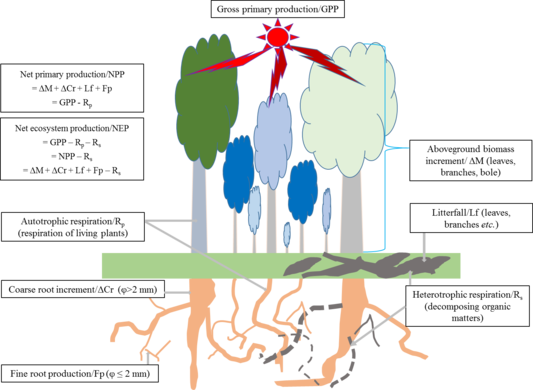Trees produce biomass from H2O and CO2 through photosynthesis, the biomass is stored in forest ecosystem. The living biomass is stored in roots, leaves, branches, stems etc. While, dead biomass (organic matter) in the soil and on forest floor is decomposed by microorganisms to release nutrient to soil and emit CO2 to the atmosphere. Both photosynthesis and decomposition processes occur simultaneously in ecosystem. This is briefly known as forest carbon cycle. After autotrophic respiration (Rp) — respiration of plants to sustain their life, amount of biomass stored in forest ecosystem is known as Net Primary Production (NPP). Meanwhile, decomposing dead biomass is known as heterotrophic respiration (Rs). If NPP is larger than Rs, ecosystem is accumulating carbon.
Net Ecosystem Production (NEP) is a fundamental property of ecosystem. It was originally defined as the difference between the amount of organic carbon fixed by photosynthesis in an ecosystem (gross primary production) and total ecosystem respiration (the sum of autotrophic and heterotrophic respiration). Basing on this definition, NEP represents the organic carbon available for storage within ecosystem or loss from it by export or non-biological oxidation. In other way, NEP is usually described as the balance between NPP and Rs in an ecosystem.
Additional information on forest carbon worldwide is required to understand and control global carbon cycle, and to support regulatory REDD (Reduce Emission from Deforestation and forest Degradation). REDD is an effort to create a financial value for the carbon stored in forests, offering incentives for developing countries to reduce emissions from forested lands. REDD can be economically viable and will be accepted by the providers only if the payment for the avoided deforestation and degradation is at least as large as the opportunity cost plus transaction costs. One of the first steps towards implementation of REDD in a country level is to estimate forest carbon/NEP. Which are crucial for REDD monitoring and subsequent fundraising from public fund or carbon market.
 図 森林炭素サイクル(生態系生産量の推定)
図 森林炭素サイクル(生態系生産量の推定)
Forest carbon cycle (estimating Net Ecosystem Production)
ページ先頭へもどる
2018年4月20日作成


